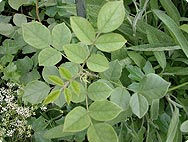A.Vogel search
When the internal search is activated, personal data such as your IP address is transmitted to our search engine Cludo. Data is thus transferred to a third country. Please click here if you want to display the internal search. You can find more information on data protection here: Privacy policy.
A.Vogel plant encyclopaedia
Glycyrrhiza glabra L.
Licorice / Liquorice
History

The genus name Glycyrrhiza derives from the Greek glykys, for "sweet", and rhiza, for "root". In late antiquity, the word was Latinized; the resulting "liquiritia" made its way into the German "Lakritze", the English "licorice", "liquorice", and the French "réglisse". The species name glabra is derived from the Latin glaber, which means "smooth" or "bald" and refers to the smooth husks.
Licorice plants were known in Chinese medicine as early as 2800 B.C. In Tibet they were considered a classical medicine. In the tomb of the Egyptian pharaoh Tutanchamon (1350 B.C.), the healing power of licorice roots is described. The use of licorice preparations to alleviate throat and bronchial infections is documented for more than 2000 years!
In the Middle Ages, licorice was cultivated in Central Europe much more frequently than today. Remnants of this cultivation continued into the beginning of the 20th century. In Europe, the drug was long used only as an expectorant and flavoring agent. The beneficial effect of licorice in stomach diseases was not described until 1950.
Botanical characteristics
Licorice is a perennial, robust, herbaceous plant growing up to 1.5 m high with an extensive root system consisting of a tap root, root branches, and long runners. The woody stalk bears a loose foliage with unpaired pinnate, narrowly lanceolate leaves covered with sticky glandular hairs. The erect, 10 to 15 cm long blossom clusters grow from the leaf axils and bear numerous blue-lilac, blue-violet, or white-pink blossoms.
Licorice flowers from June to July.
Habitat

The licorice bush is native to Asia Minor and the Caucasus. It is found in the Mediterranean region, in the Balkans, and in the Near East. It loves sandy soil and grows in wasteland and dry river beds. Its feral occurrence from old cultivation is so widespread that it seldom must be cultivated today.
In trade, distinctions are made between Spanish, Russian, Chinese, and Persian licorice. These varieties do not necessarily come from these respective countries; the terms designate different varieties of Glycyrrhiza glabra L. (var. typica, var. glandulifera, var. pallida, var. violacea, etc.) as well as varying appearances. Spanish licorice, for example, consists of unpeeled runners, while Russian licorice is sold in irregular, peeled pieces [1,2].
Preparation
To prepare the mother tincture, first-class trade ware from Iran is cut fine and macerated with alcohol.
Due to its sweet taste, licorice plays an important role as a flavoring agent for bad-tasting or nauseating medications. Licorice extracts are used in the candy industry, in beer breweries, in liqueur and brandy manufacturing, and in the tobacco industry. The root is often already made into licorice candy in the countries of origin.